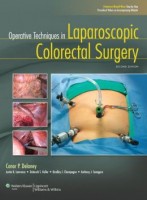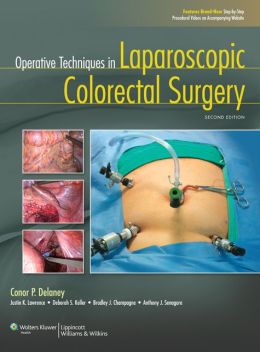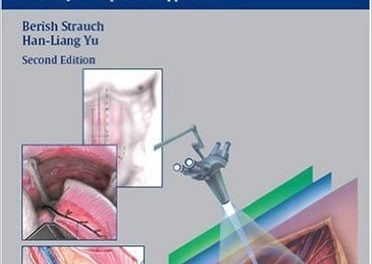 Authors: Conor P. Delaney, Justin K. Lawrence, Deborah S. Keller, Bradley J. Champagne, and Anthony J. Senagore
Authors: Conor P. Delaney, Justin K. Lawrence, Deborah S. Keller, Bradley J. Champagne, and Anthony J. Senagore
Publisher: Wolters Kluwer | Lippincott, Williams & Wilkins – 228 pages
Book Review by: Nano Khilnani
Laparoscopy is a minimally-invasive surgical or diagnostic procedure that uses a flexible endoscope (called a laparoscope) inserted through the navel to view and operate on structures in the abdomen. There are several reasons surgeons chose laparoscopic procedures over conventional surgery:
- Decreased postoperative analgesic (reduction of pain) requirements
- Faster return of bowel function
- Quicker resumption of oral intake
- Shorter hospital stay
- Better cosmesis, or minimal scarring of the abdominal area
- Lower cost
The authors of this book point out in their Preface that laparoscopic surgery has already been long established as a safe and effective means of performing functions that were previously done through open surgery, which requires incisions and other tasks for the surgeon.
While there are many benefits of laparoscopic surgery involving the colon and rectum, the authors write that you the intending surgeon need adequate learning and appropriate training before you can add laparoscopic colorectal surgery to your repertoire of procedures that you can do easily and successfully. The authors point out what you need
- A multifaceted approach of technical knowledge for the operative steps of each procedure
- Observation for pattern recognition
- Hands-on experience
This second edition of Laparoscopic Colorectal Surgery provides detailed descriptions of procedural steps, common pitfalls, and pattern recognition. Photographs of important landmarks and an edited video of the key steps of each procedure are provided for you if you are contemplating to learn and practice laparoscopic colorectal surgery.
This book comes with access to the complete contents online, full searchable, plus other valuable features. Scratch off the gray sticker on the inside front cover of your book to get your access code. Three simple steps to gain instant access:
1) Visit http://solution.lww.com
2) Enter your access code
3) Follow the instructions to activate your access
For technical assistance, call 1-800-468-1128 in the United States or 1-410-528-4000 outside the U.S., or email: CustomerService@LWW.com
The detailed steps along with numerous images of different procedures are contained in 29 chapters organized around four sections, namely:
Instrumentation, Requirements, and Perioperative Care Pathways – training, initial case selection, and postoperative care; equipment, operating room setup, and patient positioning; port placement, laparoscopic specimen extraction site, and port site closure.
- Key Steps – high and low ligation of the inferior mesenteric artery; ileocolic artery ligation; hepatic flexure mobilization; mobilization of the splenic flexure; mobilizing the mesorectum; division of the upper and lower rectum; stapled coloanal and colorectal anastomoses; specimen extraction for very low tumors and hand-sewn coloanal anastomosis.
- Operative Procedures – laparoscopic right hemicolectomy; hand-assisted laparoscopic hemicolectomy; robotic single-port right hemicolectomy; laparoscopic sigmoid colectomy; hand-assisted laparoscopic sigmoid colectomy; laparoscopic total abdominal colectomy with ileorectal anastomosis; total proctocolectomy with ileal pouch-anal anastomosis; single-incision laparoscopic total abdominal colectomy with end ileostomy;
- Operative Procedures, continued – laparoscopic low anterior resection; laparoscopic abdomino-perineal resection; robotic-assisted low anterior resection; laparoscopic Well’s rectopexy; laparoscopic resection rectopexy; laparoscopic loop ileostomy and loop colostomy formation; laparoscopic Hartmann’s Procedure; laparoscopic reversal of Hartmann’s Procedure.
- Dealing with Complications and Difficult Situations – complications and difficulties; additional operative procedures.
Authors:
Conor P. Delaney, MD, MCh, PhD is the Jeffrey L. Ponsky Professor Surgical Education; Chief of the Division of Colorectal Surgery; Vice Chair, Department of Surgery; Director, CWRU Center for Sills and Stimulation; and Surgical Director, UH Digestive Health Institute; at University Hospitals Case Medical Center at Case Western Reserve University in Cleveland, Ohio.
Justin K. Lawrence, MBBS, BSc., MRCS is Registrar, General Surgery at Southland University Hospital in Essex, United Kingdom.
Deborah S. Keller, MS, MD is Research Fellow in the Division of Colorectal Surgery in the Department of Surgery at University Hospitals Case Medical Center in Cleveland, Ohio.
Bradley J. Champagne, MD is Program Director of the Laparoscopic Colorectal Fellowship at University Hospitals Case Medical Center; and Associate Professor of Surgery at Case Western Reserve University School of Medicine in Cleveland, Ohio,
Anthony J. Senagore, MD, MS, MBA is Chair of Surgical Disciplines at Central Michigan University School of Medicine in Mount Pleasant, Michigan.







